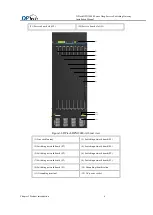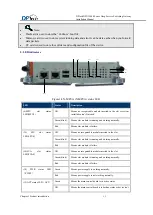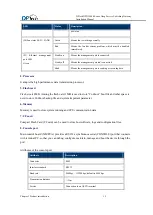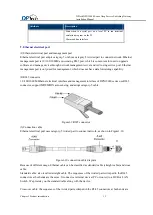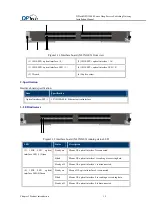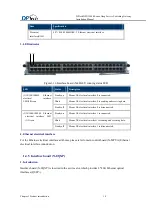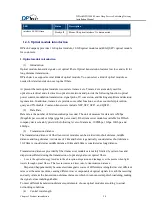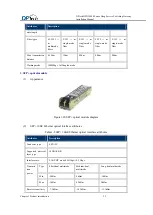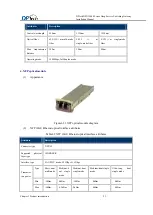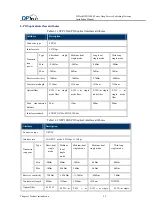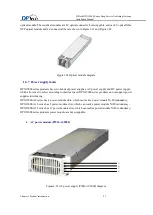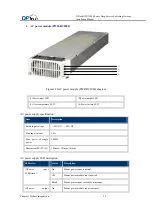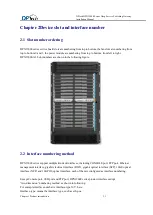
DPtech DPX19000 Series Deep Service Switching Gateway
Installation Manual
Chapter 1 Product introudction
20
LED
Status
Description
interface LED(3)Green
Steady off
Means GE optical interface 3 is disconnected.
1.4.6 Optical module introduction
DPtech Company provides 1 GE optical module, 10 GE optical module and 40G QSFP+ optical module
for customers.
1. Optical module introduction
(1)
Introduction
Optical module transmits signals over optical fibers. Optical transmission features low loss and is fit for
long distance transmission.
DPtech devices support several kinds of optical module. You can select a kind of optical module as
needed for data transmission over optical fibers.
At present the main optical module we used are transceivers. Transceivers are mainly used for
optical-to-electrical and electrical-to-optical conversions and provide the following function: optical
power control, modulation transmission, signal probe, IV conversion, and limiting amplifier and decision
regeneration. In addition, transceivers provide some other functions, such as counterfeit-prevention
query and TX-disable. Common transceivers include XFP, SFP, SFP+, and QSFP+.
(2)
Data Rate
Data rate is the number of bits transmitted per second. The unit of measure for data rate is Mbps
(Megabits per second) or Gbps (gigabits per second). Fiber transceiver modules available for DPtech
company devices mainly provide the following levels of data rates: 100Mbps, 1Gbps, 10Gbps, and
40Gbps.
(3)
Transmission distance
The transmission distance of fiber transceiver modules can be divided into short distance, middle
distance and long distance. A distance of 2 km and below is generically considered as short distance.
10~20km is considered as middle distance, 30km and 40km is considered as long distance.
Transmission distances provided by fiber transceiver modules are mainly limited by certain loss and
dispersion suffered during the transmission of optical signals over optical fibers.
•
Loss is the optical energy loss due to the absorption, dispersion and leakage over the media when light
travels through optical fibers. This loss increases in direct ratio to transmission distance.
•
Dispersion happens mainly because electromagnetic waves of different wavelengths travel at different
rates over the same medium, causing different wave components of optical signals to reach the receiving
end early or late as the transmission distance increases, which in turn causes impulse broadening, making
the signal values indistinguishable.
To meet different transmission distance requirements, choose optical modules according to actual
networking conditions.
(4)
Central wavelength
Summary of Contents for DPX19000 Series
Page 67: ...Chapter 6 Troubleshooting 1 ...

